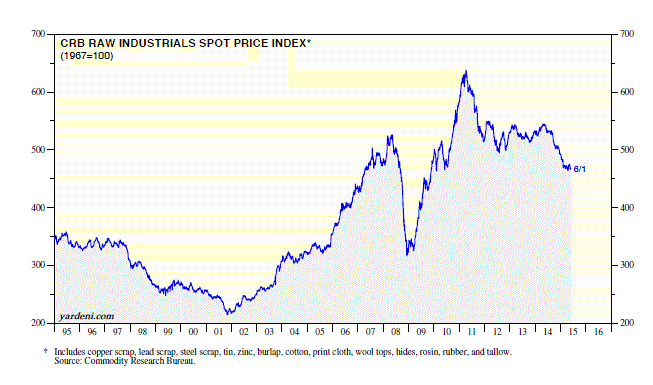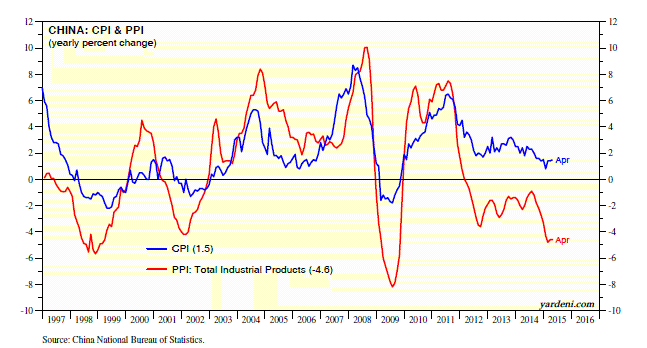
Monday’s WSJ included an article titled “Glut of Chinese Goods Pinches Global Economy.” The main point is that “China’s excess manufacturing capacity and slowing growth rate are … putting renewed downward pressure on prices.” I have been expounding on this theme for quite some time, so I obviously think the article is worth reading.
When China’s economy was booming, so did its demand for commodities. The result was the commodity super-cycle, which started in late 2001 after China joined the World Trade Organization on December 11 of that year. The super-cycle was briefly interrupted by the financial crisis of 2008. However, the Chinese government responded to it with a major fiscal stimulus program while the PBOC pumped lots of credit into the economy. Other governments and central banks did the same, but the Chinese led the way.
As a result, commodity prices soared again in 2009 through 2010. However, China’s factories turned expensive commodities into lots of cheap manufactured goods thanks to the availability of cheap labor. In other words, the trend in the so-called “China Price” was disinflationary, if not deflationary for the world economy. For the seven countries that report their CPIs by goods and services, durable goods prices have been falling steadily since the start of 2001: Eurozone (-1.7%), US (-12.5), UK (-13.7), Sweden (-21.6), Taiwan (-22.3), Switzerland (-23.9), and Japan (-43.7).
But China’s economic growth peaked during 2010, and labor costs started rising. The commodity super-cycle wasn’t so super, lasting just 10 years rather than 25-50 years. The subsequent drop in commodity prices since 2010 depressed commodity producers. Nevertheless, the China Price continues to fall as Chinese factories replace labor with automation. The 5/5 South China Morning Post included an article titled, “Building work starts on first all-robot manufacturing plant in China’s Dongguan.” A total of 1,000 robots will be installed at the factory, run by Shenzhen Everwin Precision Technology Co, with the aim of reducing the current workforce of 1,800 by 90% to only about 200.
To avert large-scale unemployment, the government continues to provide fiscal and monetary stimulus, which only worsens the excess capacity problem in manufacturing.
The WSJ article cited above reports:
“Prices of all goods imported to the U.S. directly from China have fallen in 20 of the past 38 months, by 2.2% in all. For U.S. consumers, that is good news. But for policy makers and corporate executives, declining prices present a real challenge. The declines can sap profitability, deter investment and block wage growth, all of which are needed to help the world break out of its years of underwhelming growth.”
The article notes, as I have on a regular basis, that China’s PPI has declined on a y/y basis for 38 consecutive months. The PBOC has responded by easing credit conditions, which is likely to boost excess capacity by keeping “zombie” companies in business and by spurring even more capacity expansion.
Today's Morning Briefing: Blaming China. (1) No shortage of gluts thanks to China. (2) The epicenter of deflation. (3) Not so super super-cycle. (4) “China Price” remains deflationary as robots replace humans. (5) Deal or no deal? (6) Lots of big deals in healthcare, IT, and telecom. (7) Fed financing M&A mega-boom. (8) The fastest and easiest way to grow. (9) Challenging time for active managers. (10) Dividend-yielding stocks underperforming. (11) Focus on market-weight-rated S&P 500 auto-related industries.

